Special Issue of Symposium on Single-Atom Catalysis (ISSAC-2016)
Posted 催化学报CJCatal
tags:
篇首语:本文由小常识网(cha138.com)小编为大家整理,主要介绍了Special Issue of Symposium on Single-Atom Catalysis (ISSAC-2016)相关的知识,希望对你有一定的参考价值。
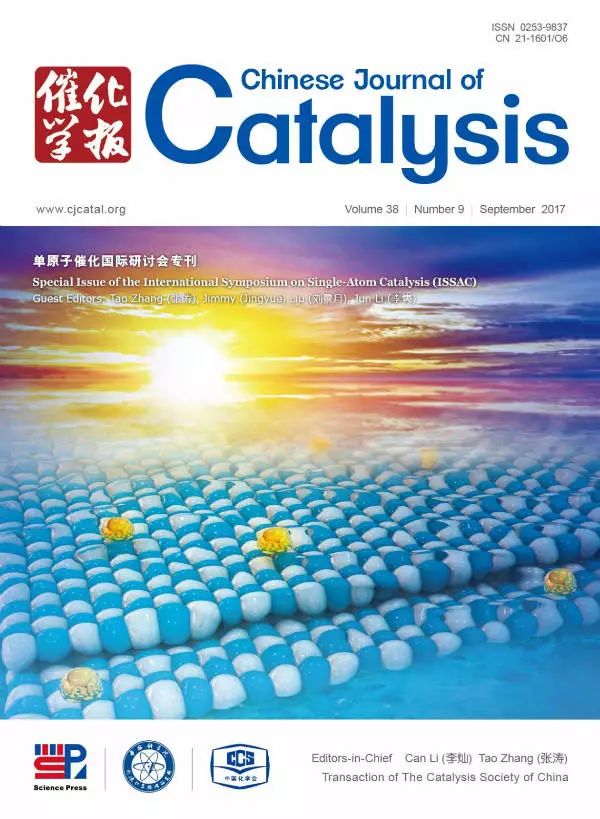
The concept of single-atom catalysts (SAC), defined as isolated atoms individually dispersed on a solid materials, was first raised in 2011 in a seminal work produced from the cooperation of Professors Tao Zhang, Jingyue (Jimmy) Liu and Jun Li. This concept attracted considerable interests in the following years and initiated extensive investigation and has now been one of the frontiers in heterogeneous catalysis.
This special issue collects 23 papers with 1 viewpoint, 6 perspectives, 2 full reviews, 2 minireviews and 12 original research papers.
Here are the contents of the special issue.
Click " read the original (阅读原文)" at the bottom of the page to view the article online and download it for free.
Preface to the Special Issue of the International Symposium on Single-Atom Catalysis (ISSAC-2016)
Jun Li, Jimmy (Jingyue) Liu, Tao Zhang

Supported metal catalysts at the single-atom limit – A viewpoint
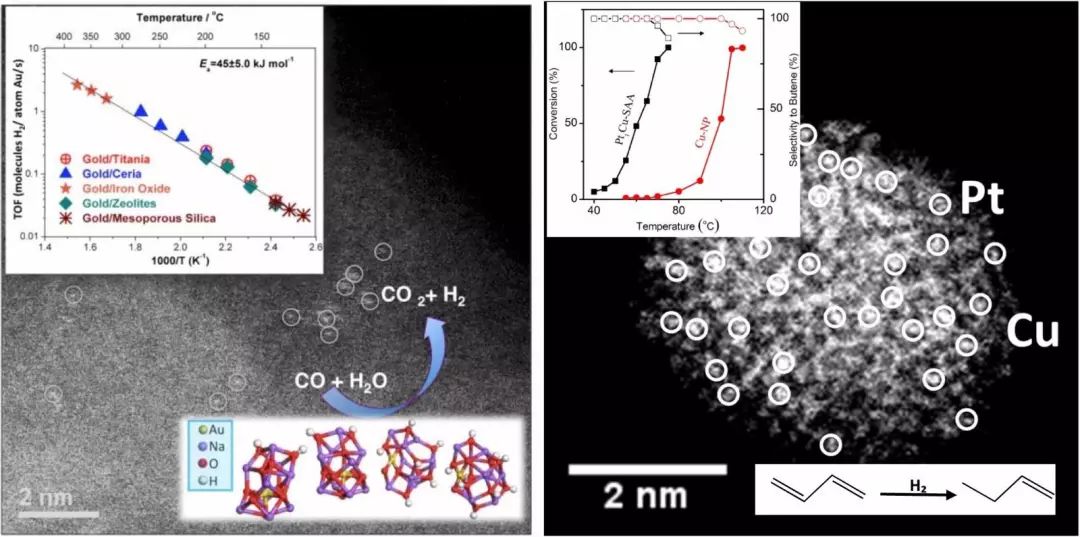
Single metal atoms supported on oxides catalyze the water-gas shift reaction. Single Atom Alloys (SAAs) comprise single metal atoms embedded in another metal surface. Shown here is the selective hydrogenation of butadiene to butene over PtCu SAAs at near ambient temperatures.
Two-dimensional materials confining single atoms for catalysis
Yong Wang, Wenhua Zhang, Dehui Deng, Xinhe Bao
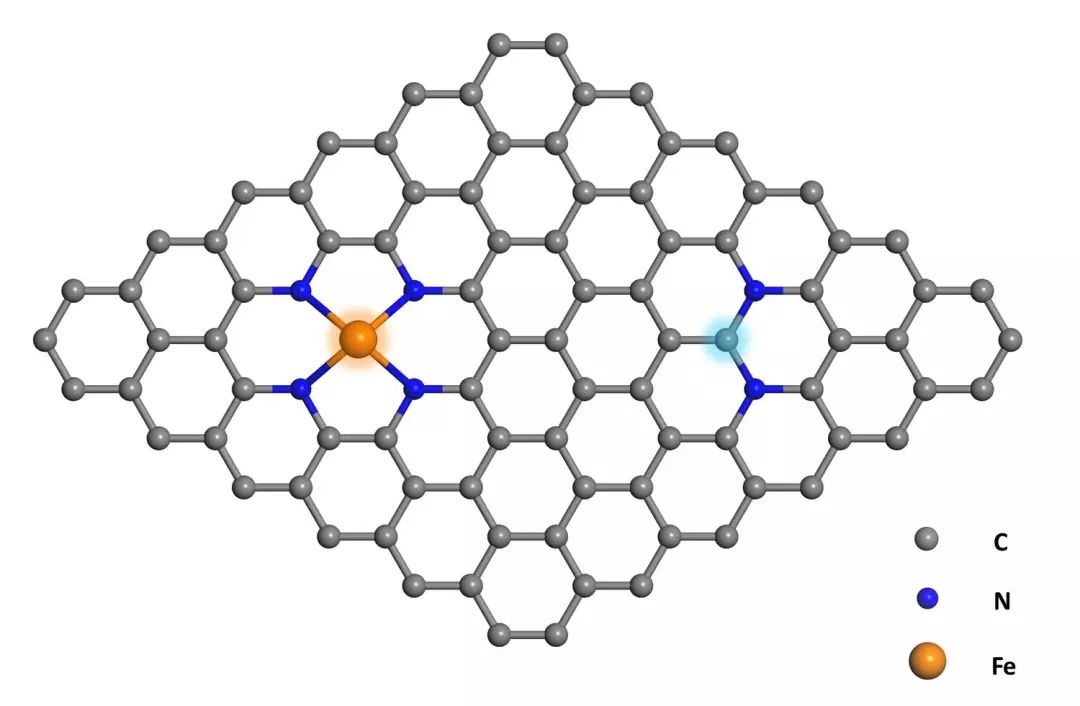
Two-dimensional materials confining single atoms, the mutually beneficial cooperation for highly efficient catalysis.
Unravelling single atom catalysis: The surface science approach
Gareth S. Parkinson
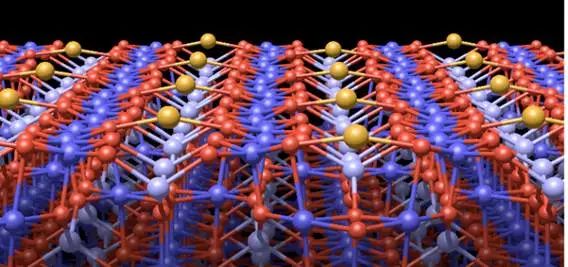
This perspective discusses how studies of idealised model systems can shed light on the fundamental mechanisms of single-atom catalysis. The image shows Au adatoms supported by Fe3O4(001).
Aberration-corrected scanning transmission electron microscopy in single-atom catalysis: Probing the catalytically active centers
Jingyue (Jimmy) Liu
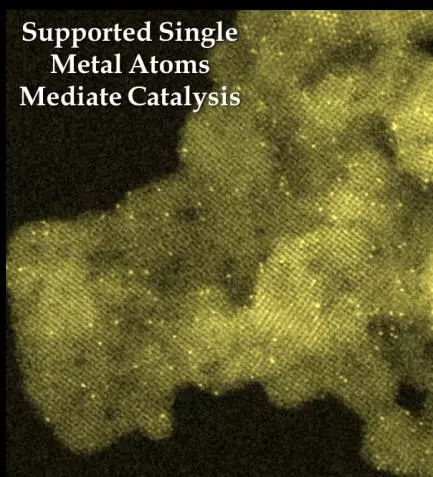
Aberration-corrected scanning transmission electron microscopy techniques are indispensable for understanding catalysis by supported single metal atoms and for developing practical single-atom catalysts for energy and chemical transformations.
Using probe molecule FTIR spectroscopy to identify and characterize Pt-group metal based single atom catalysts
Chithra Asokan, Leo DeRita, Phillip Christopher
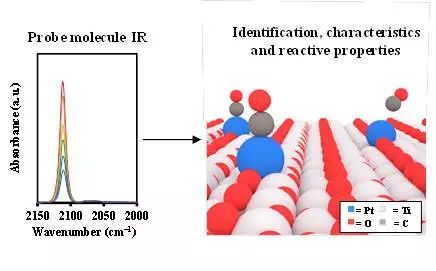
The utility, applications, and future directions of using probe molecule IR spectroscopy for identifying and characterizing catalysts consisting of supported Pt group metal single atom catalysts is presented in this perspective.
X-ray absorption spectroscopy for single-atom catalysts:Critical importance and persistent challenges
Isao Ogino

X-ray absorption spectroscopy is an essential technique to investigate the structure-performance relationship of single-atom catalysts. To benefit most from this powerful technique and perform high-level analysis, structural uniformity of active sites is highly desirable.
Increasing the range of non-noble-metal single-atom catalysts
Ting Deng, Weitao Zheng, Wei Zhang
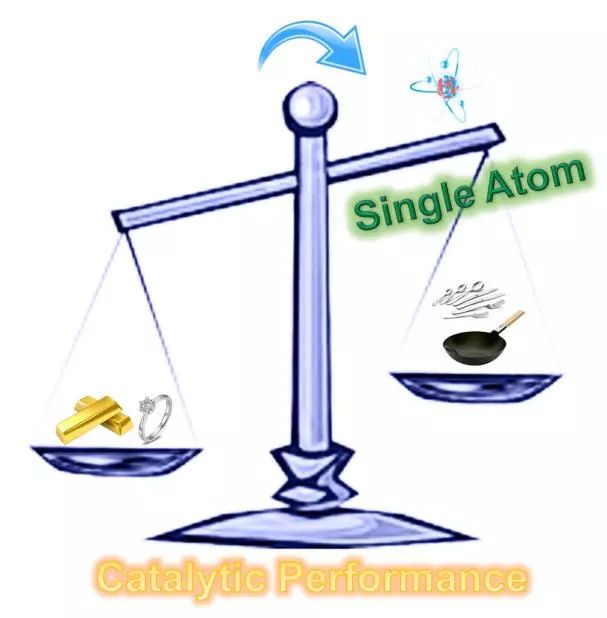
The catalytic performances of non-noble metals are inferior to those of noble metals. The advent of single-atom catalysts (SACs) has shifted the balance. Experimental and theoretical studies have shown that non-noble-metal SACs have a promising future in various key reactions.
Highlights of the major progress in single-atom catalysisin 2015 and 2016
Bing Han, Rui Lang, Botao Qiao, Aiqin Wang, Tao Zhang
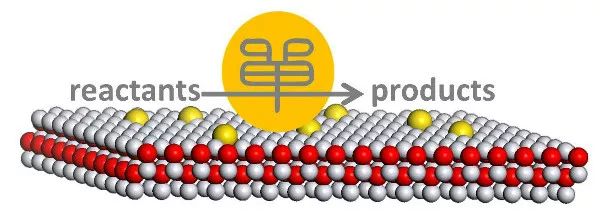
The latest developments in single-atom catalysis are highlighted, including new approaches in single-atom catalyst (SAC) synthesis, stable gold SACs, highly selective platinum and palladium SACs, and non-noble metal SACs in electrochemistry.
Single atom catalyst by atomic layer deposition technique
Niancai Cheng, Xueliang (Andy) Sun
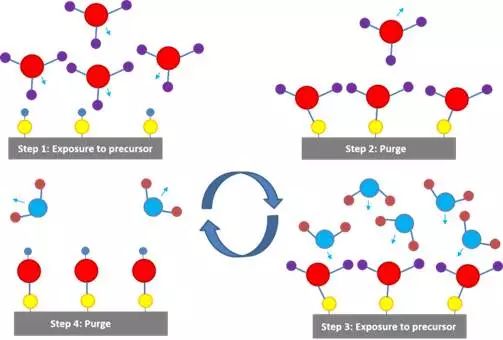
This review summarizes recent development of single atom catalyst synthesized by atomic layer deposition and explores future research directions and trends.
Metal-mediated catalysis in the gas phase: A review
Xiao-Na Li, Xiu-Ping Zou, Sheng-Gui He

In this review, the experimentally identified gas-phase catalytic cycles mediated by atomic metal ions, bare metal clusters, metal oxide clusters, and metal complexes are summarized with an emphasis on the reactivity of cluster confined single-atom catalysts.
Preparation, characterization and catalytic performance of single-atom catalysts
Liqiong Wang, Liang Huang, Feng Liang, Simin Liu, Yuhua Wang, Haijun Zhang
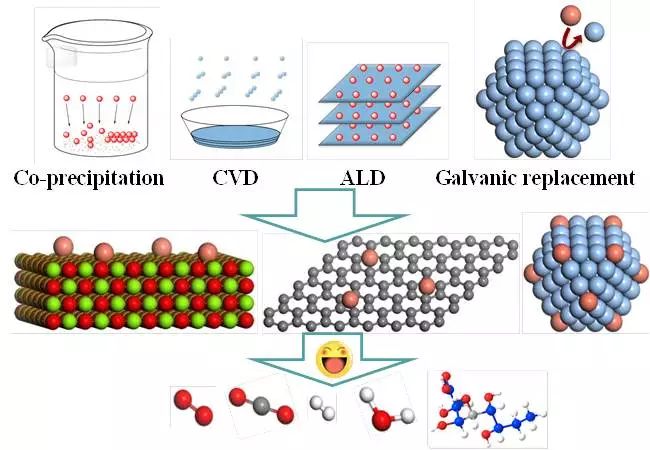
Single-atom catalysts (SACs) have become a desirable research topic. The preparation, characterization and catalytic performance of three kinds of SACs with single atoms anchored onto metal oxides, two-dimensional materials and metal nanoclusters are summarized.
Isolation of Pd atoms by Cu for semi-hydrogenation of acetylene: Effects of
Cu loading
Guangxian Pei, Xiaoyan Liu, Mengqian Chai,
Aiqin Wang, Tao Zhang

Cu-alloyed Pd single-atom catalysts were formed for Cu/Pd atomic ratios ≥ 40/1 and displayed excellent catalytic performance for the semi-hydrogenation of acetylene in excess ethylene.
Probing the catalytic behavior of ZnO nanowire supported Pd1 single-atom
catalyst for selected reactions
Jia Xu, Yian Song, Honglu Wu, Jingyue Liu
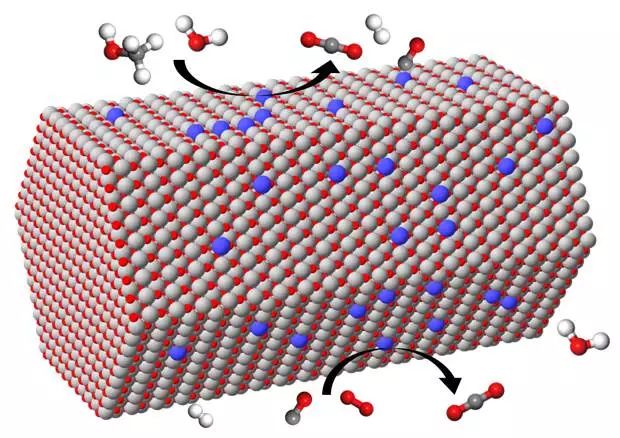
ZnO nanowire supported Pd single-atom catalysts (SACs) were synthesized and evaluated for selected catalytic reactions and the Pd1/ZnO SAC demonstrated excellent activity and selectivity for steam reforming of methanol to produce hydrogen.
Investigation of water adsorption and dissociation on Au1/CeO2 single-atom catalysts using density functional
theory
Yan Tang, Yang-Gang Wang, Jin-Xia Liang, Jun Li
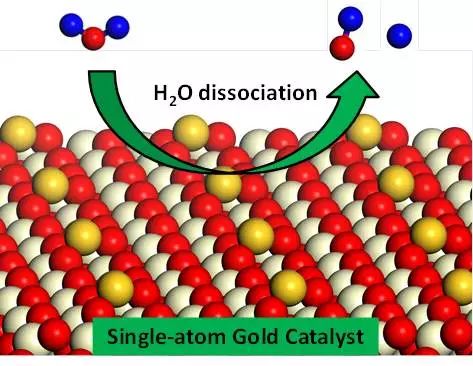
Positively charged single-atom Au on ceria support is a potential catalyst for water dissociation. It can not only provide the activation site for water adsorption but also facilitate water dissociation by weakening the intramolecular O–H bond.
Catalytic ativities of single-atom catalysts for CO oxidation: Pt1/FeOx vs. Fe1/FeOx
Jinxia Liang, Xiaofeng Yang, Congqiao Xu,
Tao Zhang, Jun Li
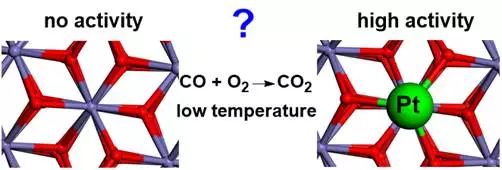
Pt1/FeOx has higher catalytic activity for CO oxidation than that of the FeOx substrate alone because the regeneration of oxygen vacancies features a high activation barrier for desorption of a second CO2 molecule at the surface of Fe1/FeOx (i.e., the FeOx substrate).
Photochemical route for preparing atomically dispersedPd1/TiO2 catalysts on (001)-exposed anatase nanocrystals and P25
Pengxin Liu, Jie Chen, Nanfeng Zheng
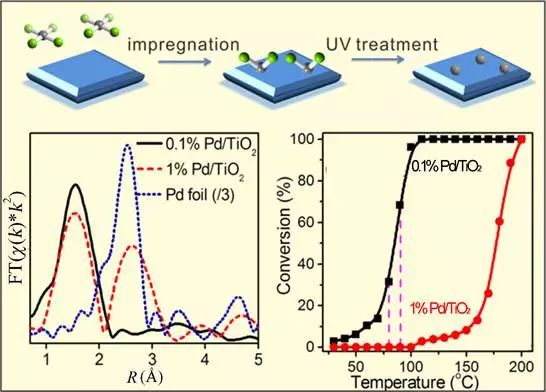
Pd1/TiO2 catalysts prepared via a photochemical route showed excellent catalytic activities and stabilities in both styrene hydrogenation and CO oxidation.
Coating Pd/Al2O3 catalysts with FeOx enhances both activity and selectivity in
1,3-butadiene hydrogenation
Hong Yi, Yujia Xia, Huan Yan, Junling Lu
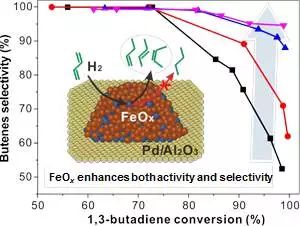
Deposition of FeOx onto Pd/Al2O3 catalyst can remarkably improve both hydrogenation activity and butenes selectivity through the electronic effect and geometric effect, respectively.
Top-down synthesis strategies: Maximum noble-metal atom efficiency in catalytic materials
Yaxin Chen, Zhiwei Huang, Xiao Gu, Zhen Ma, Jianmin Chen, Xingfu Tang
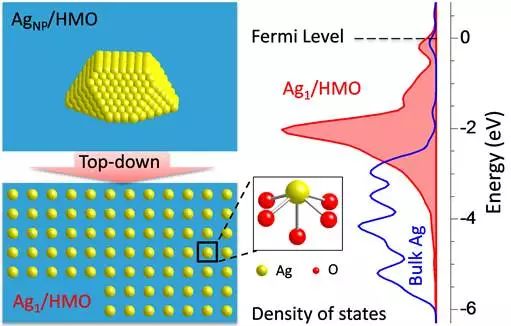
The top-down strategy is successfully used to synthesize atomically dispersed metal catalysts from supported Ag nanoparticles by a thermal diffusion process. The driving force is attributed to the electronic perturbation of the Ag frontier orbitals.
Identification of active sites for hydrogenation over Ru/SBA-15 using
in situ Fourier-transform infrared
spectroscopy
Hangjia Shen, Xianyuan Wu, Dahao Jiang,
Xiaonian Li, Jun Ni

The active sites for hydrogenation over Ru/SBA-15 catalysts were identified using in situ FTIR spectroscopy. The formation of these active sites is probably an intermediate step in hydrogen spillover.
Effect of pretreatment conditions on catalytic activity of Ag/SBA-15 catalyst for toluene oxidation
Yuan Qin, Zhenping Qu, Cui Dong, Na Huang
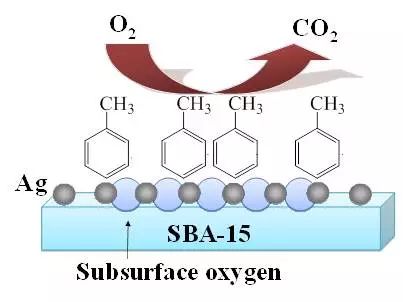
Redispersed, small Ag particles on the O500-H300 sample show high activation ability for O2 and great affinity with toluene because of the formation of subsurface oxygen, leading to high catalytic activity for toluene oxidation.
Effect of the degree of dispersion of Pt over MgAl2O4 on the catalytic hydrogenation of benzaldehyde
Feng Yan, Caixian Zhao, Lanhua Yi, Jingcai Zhang, Binghui Ge, Tao Zhang, Weizhen Li

MgAl2O4-supported Pt single-atom catalysts are highly active in the selective hydrogenation of benzaldehyde to benzyl alcohol. Pt nanocatalysts are more active but less selective, presumably because of the formation of Pt terraces.
Mechanistic understanding on oxygen evolution reactionon γ-FeOOH (010)
under alkaline condition based on DFT
computational study
Miru Tang, Qingfeng Ge

Oxygen evolution mechanism on FeOOH (010) catalyst under the alkaline condition. The circled OH- represent hydroxide ions in solution. Blue sphere is Fe, red O and white H.
Three-dimensionally ordered macroporous CeO2/Al2O3-supported Au nanoparticle catalysts: Effects of CeO2 nanolayers on catalytic activity in soot oxidation
Baofang Jin, Yuechang Wei, Zhen Zhao, Jian Liu, Yazhao Li, Renjie Li, Aijun Duan, Guiyuan Jiang
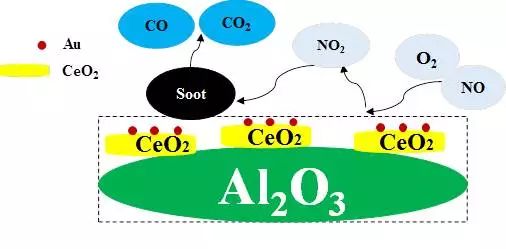
A mixed oxide catalyst containing Au, CeO2, and Al2O3 combines the benefits of high activity, good redox properties, and high surface area, and provides a highly effective catalyst for soot oxidation.


2018
HAPPY NEW YEAR


金鸡鸣啼辞旧岁,玉犬摇尾迎新年。辞旧迎新,欢度新年。《催化学报》编辑部成员祝您如意吉祥幸福安康!
点击"阅读原文"
以上是关于Special Issue of Symposium on Single-Atom Catalysis (ISSAC-2016)的主要内容,如果未能解决你的问题,请参考以下文章
893. Groups of Special-Equivalent Strings
[Solution] 893. Groups of Special-Equivalent Strings
Special Attributes Of Class类的特殊属性
CF1156E Special Segments of Permutation